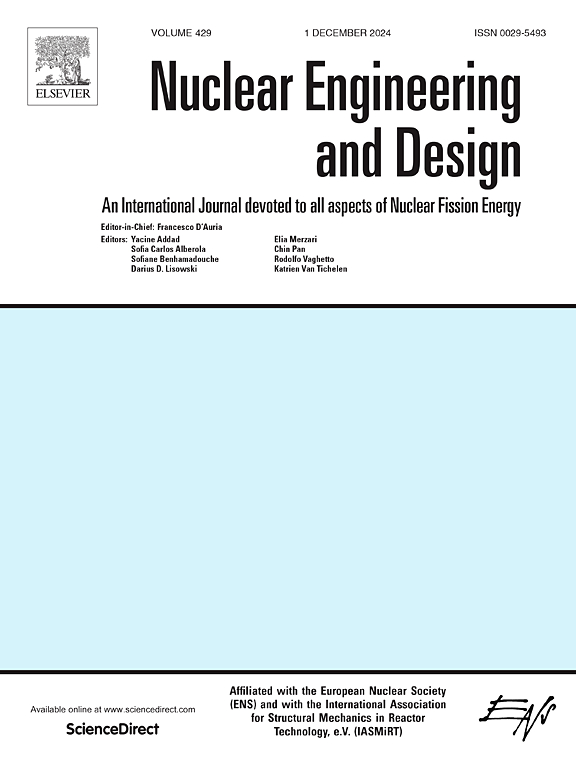Formation of gas bubble superlattice in U-Mo alloys: A phase-field study
IF 2.1
3区 工程技术
Q1 NUCLEAR SCIENCE & TECHNOLOGY
引用次数: 0
Abstract
The impact of grain boundary (GB) on the formation and evolution of gas bubble superlattices (GBS) in U-Mo alloys under irradiation is critical for understanding the material behavior in nuclear environments. In this study, a phase-field model coupled Kim-Kim-Suzuki (KKS) model and explicit nucleation algorithm was developed to simulate GBS formation. The accumulation of vacancies and gas atoms led to bubble nucleation, with directional migration of interstitial atoms inducing a shadow effect and causing ordered bubble arrangements. The GBS exhibited stability, with bubble size and lattice constants remaining nearly constant at higher fission densities. The GB was shown to influence GBS formation significantly, with the surrounding region divided into a denuded zone and a peak zone. The width of the denuded zone is influenced by the GB properties. In this work, the relationship between the denuded zone width and the GB absorption strength was derived using a one-dimensional steady-state vacancy diffusion equation. It was found that the denuded zone width increases with an increase in the GB absorption coefficient. The phase-field simulation results were consistent with theoretical predictions. These findings contribute to a better understanding of how GBs affect irradiation-induced microstructural changes in nuclear materials.

U-Mo合金中气泡超晶格形成的相场研究
研究辐照下U-Mo合金的晶界对气泡超晶格的形成和演化的影响,对于理解材料在核环境中的行为具有重要意义。在本研究中,建立了一个相场模型耦合Kim-Kim-Suzuki (KKS)模型和显式成核算法来模拟GBS的形成。空位和气体原子的聚集导致气泡成核,间隙原子的定向迁移引起阴影效应并导致有序的气泡排列。GBS表现出稳定性,在较高的裂变密度下,气泡大小和晶格常数几乎保持不变。GB对GBS的形成有明显的影响,其周围区域分为剥蚀带和峰带。剥蚀带的宽度受GB性能的影响。本文利用一维稳态空位扩散方程,推导了光蚀带宽度与GB吸收强度之间的关系。随着GB吸收系数的增大,剥蚀带宽度增大。相场模拟结果与理论预测一致。这些发现有助于更好地理解gbbs如何影响辐照引起的核材料微结构变化。
本文章由计算机程序翻译,如有差异,请以英文原文为准。
求助全文
约1分钟内获得全文
求助全文
来源期刊

Nuclear Engineering and Design
工程技术-核科学技术
CiteScore
3.40
自引率
11.80%
发文量
377
审稿时长
5 months
期刊介绍:
Nuclear Engineering and Design covers the wide range of disciplines involved in the engineering, design, safety and construction of nuclear fission reactors. The Editors welcome papers both on applied and innovative aspects and developments in nuclear science and technology.
Fundamentals of Reactor Design include:
• Thermal-Hydraulics and Core Physics
• Safety Analysis, Risk Assessment (PSA)
• Structural and Mechanical Engineering
• Materials Science
• Fuel Behavior and Design
• Structural Plant Design
• Engineering of Reactor Components
• Experiments
Aspects beyond fundamentals of Reactor Design covered:
• Accident Mitigation Measures
• Reactor Control Systems
• Licensing Issues
• Safeguard Engineering
• Economy of Plants
• Reprocessing / Waste Disposal
• Applications of Nuclear Energy
• Maintenance
• Decommissioning
Papers on new reactor ideas and developments (Generation IV reactors) such as inherently safe modular HTRs, High Performance LWRs/HWRs and LMFBs/GFR will be considered; Actinide Burners, Accelerator Driven Systems, Energy Amplifiers and other special designs of power and research reactors and their applications are also encouraged.
 求助内容:
求助内容: 应助结果提醒方式:
应助结果提醒方式:


